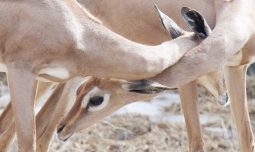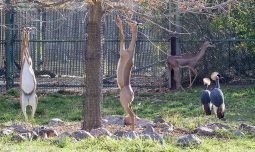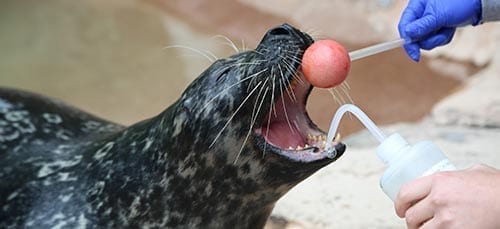Classification
Class Mammalia
Order Artiodactyla
Family Bovidae
Genus Litocranius
Species walleri
Subspecies walleri
Habitat & Range
Southern gerenuks live in the east African countries of Kenya, Ethiopia, Somalia and northeastern Tanzania.
Their habitat varies from semi-arid brush land to dry deserts. They avoid dense woodland and open grassland.

Southern Gerenuk
Litocranius walleri walleri
Long legs, long necks and large eyes distinguish gerenuks from other African antelope. Unlike many other four-legged herbivores these petite animals often dine balanced on their hind legs. Using this adaptation, gerenuks can eat leaves from high on bushes and shrubs that almost no other animal can reach.
Adaptations
- Several traits enable southern gerenuks to reach foliage that most other animals cannot access.
o Their strong hind legs and specially modified vertebrae allow them to stand upright on two legs, adding to their height.
o Their long necks make their standing height more than six feet (2 m).
o Because they can balance on two legs, they can use their front legs to reach and pull down branches up to eight feet (2.4 m) above ground.
- A pointed snout and long upper lip and tongue allow them to reach foliage among thorny bushes and trees.
- The diet of southern gerenuks fills virtually all of their water needs, allowing them to thrive in dry thorn bush or desert habitat.
- They are diurnal, active during the day, when predators are easier to spot.
- Their coloring provides camouflage allowing them to freeze and hide in bushes, using their long necks to watch predators; hiding behavior is important because they are not fast runners.'
- Males use their heavy horns to defend their territories against intruding males.
Physical Description
- Gerenuks’ most recognizable features are long, strong, thin legs and long slender necks.
- They are between 3 and 3.5 feet tall (90-105 cm) at the shoulder; range from 4.6 to 5.3 feet (140-160 cm) long; and weigh between 65 and 110 pounds (30-50 kg).
- Males and females are similar in size but males are more muscular and weigh more.
- Only males have large, ridged horns that curve back and up in an S-shape and range from ten to seventeen inches (25-44 cm) in length.
- They are light brown in color with reddish brown backs and white underparts; their muzzles, eyes and the insides of their large ears are rimmed in white; their coats are short and glossy.
Diet
What Does It Eat?
In the wild: Gerenuks are browsers eating a variety of tender leaves, shoots, fruits, blooms and buds.
At the zoo: Alfalfa hay, wild herbivore grain, browse (plants) and produce
What Eats It?
All of the African savanna carnivores including, lions, cheetahs, hyenas and wild dogs hunt gerenuks. They have been hunted for food by humans.
Social Organization
Gerenuks live in small groups of ten or fewer individuals, usually made up of females and their young or sub-adult males. Adult males are solitary except during mating. They establish territories that they mark with gland secretions and urine. They appear to defend their territories only from young males. Other dominant males and females with offspring roam freely throughout the marked areas.
Life Cycle
Gerenuks breed year round. Males are polygynous, mating with multiple females. Like many antelope species, male gerenuks gauge the readiness of females to mate by sniffing their urine. Once a female is ready to mate, the male marks her with secretions from scent glands beneath his eyes and follows her closely, kicking her repeatedly before mating. Following a gestation period of about seven months, females give birth to one calf; twins are rare. Newborns are able to walk within minutes after birth, but stay hidden in foliage for the first several weeks while their mother forages. They begin eating tender leaves when only a few weeks old but continue to nurse for many months. Females are weaned at about one year old, males at about eighteen months. They reach sexual maturity at approximately their weaning age. Lifespan in their historic range is ten to twelve years. In human care, they live slightly longer.
Collection Connection
- Denver Zoo has several gerenuks. They can be found in a habitat just across from the Gates Center, to the right of the main entrance.
- Echo, a male born 5/26/13, is the largest resident and the only gerenuk with horns. He runs laps around his exhibit yard and uses his horns to practice play-fighting with the ground.
- Soomi, a female born 3/30/17, came to Denver Zoo in 2018 to be paired with Echo in a Species Survival Plan (SSP) breeding recommendation.
- Agnes, a female born 9/17/19, is the daughter of Echo and Soomi. She likes to hide in tall grass demonstrating her ability to evade predators.
Conservation Status
IUCN Status: Near Threatened
Gerenuks are threatened by habitat loss from humans harvesting trees for firewood and charcoal. Wars, the presence of rinderpest, an infectious disease of ruminants, and drought also have contributed to declining population.

Download the App!
Get the FREE Denver Zoo app today, and be a pro the next time you visit the Zoo. You’ll get access to the Zoo map, daily activities and schedules, animal facts, and more. You can even load your membership card onto the app for additional convenience. It puts everything you need for an amazing Zoo experience right into the palm of your hand!





